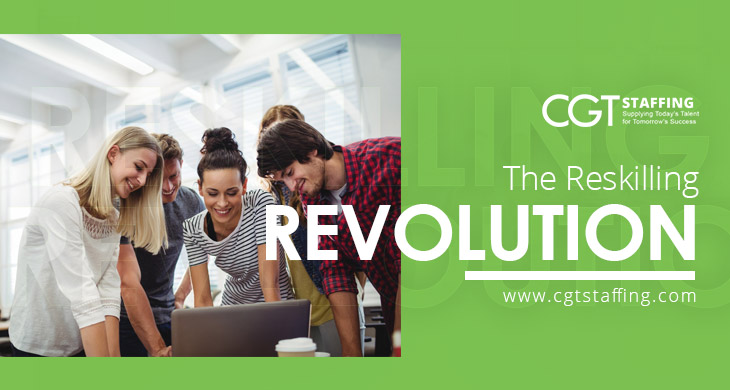COVID-19 represents one of the most disruptive events in business history. Even two years after the initial outbreak, the pandemic continues to make its impact felt, on workplaces and workforces alike. Given the scale of the global health crisis, the scale of its impact is just as diverse. In an already fluid business landscape, the pandemic has triggered and catalyzed significant transformations in a few short years, and not simply as it relates to workplace safety!
As businesses respond to these wholesale changes, their priorities now include keeping the workforce intact while meeting challenges head-on. Instead of keeping the primary focus on a talent acquisition strategy, businesses may find it more efficient to “create” the skills they need among their existing workers. Not only is this efficient in terms of cost, but it also means shorter timelines to satisfy key skill gaps. Here’s everything you need to know about the workforce trend now called the Reskilling revolution.
How the Pandemic Triggered Widespread Reskilling
Reskilling is not exactly a clutter-breaking workforce trend. Helping employees hone their existing skills and learn new ones has been part of most workplace approaches. In many cases, however, businesses are too quick to jump to the hiring part, and the debate whether a contract-to-hire vs direct-hire makes the most sense for a particular role. Even when they have skill development or enrichment programs in place, businesses have been guilty of not making use of them.
The pandemic quickly shed light on the lack of focus on reskilling. For instance, many industrial sectors now have to fight against becoming redundant. As unemployment and inflation rates rise to record highs, even more Americans are willing to walk away from unfulfilling roles during the Great Resignation. Layoffs and furloughs further impair workforce strength, and by extension, productive capacity. Given the growing hiring shortage, increased competition, and shifts in candidate pools, for many businesses, it can be fairly difficult to source the kind of talent. In certain cases, there may simply be no more demand for specific skills.
As a consequence, reskilling or upskilling the existing workforce has become a far more realistic option than in prior years. It is typically good sense to meet skill gaps through development instead of acquiring new workers in every case.
Even so, many employers remain skeptical about this approach. Regardless, businesses have very little choice when it comes to adapting to the “new normal”. Skepticism and optimism rarely factor into the very real challenges the pandemic has created or the value that a reskilling drive can lend to counter business challenges.
The Value Reskilling Delivers to Employers and Employees
Many businesses will have to invest in a workforce learning and development program following the pandemic. However, the approach has to be far more strategic, precise, and goal-focused than ever before. To maximize learning and development success, businesses will need more data-backed insights.
Acquiring this data should be as holistic as possible, including information gathered from a formal or informal workplace investigation. In the post-pandemic business world, developing skills in-house doesn’t just help minimize recruitment costs. It also helps to keep a workforce engaged and offers the necessary support to acquire new skills.
For many employers, reskilling means reconfiguring their work culture from strictly performance-focused to one that has more room to support learning. Learning new skills benefits workers by adding to the value they offer workplaces.
Their experience may not always be relevant in the post-pandemic landscape, but their ability to learn and deploy new skills productively helps them retain (or even boost) their workforce value. For businesses, a skill development program (backed by learning management systems) can strategically close key skill gaps as/when they arise.
Reskilled Workforces Is Critical to Business Sustainability
The need to reskill a workforce or a portion of the workforce is almost universal across businesses and industries. Many older workers, for instance, may be unfamiliar with or challenged when it comes to using remote working technology.
Others may have years of in-person sales experience, but none on remote or digital platforms. As an employer, especially one with centralized hiring, terminating employees only to hire new ones can prove unsustainable, not simply in terms of hiring costs or timelines, but also in the context of maintaining workforce cohesion and morale.
On the other hand, a great reskilling program can help businesses save their workers from redundancy and adjust to the new normal. In so doing, businesses can minimize workforce turnover while maximizing productivity.
